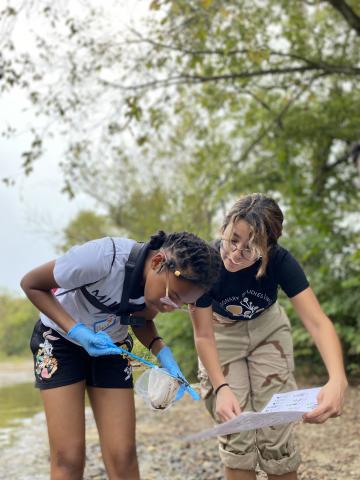Body
Image

STEM Identity Work and Play through Place-based Learning and Digital Storytelling
As young people experience challenging climate events, they may feel powerless to shape the future and uncertain about STEM-based solutions. This project focuses on the potential of place-based learning, field science, and digital storytelling to nurture diverse middle school youths’ environmental agency, STEM career knowledge, and STEM identities. The project includes out-of-school STEM learning to investigate the history, ecology, and restoration of a local watershed. The watershed has unique biodiversity and is increasingly impacted by negative climate events in a city experiencing rapid population growth. Youth create stories about the land, water, people, and history of the watershed using podcasts, augmented reality, and digital zines. Digital storytelling allows youth to recapture a sense of agency amidst climate anxiety as the stories’ digital and mobile nature can reach diverse audiences and encourage multiple ways of knowing about a socioecological system. A primary contribution is a grounded theory of identity play, which involves youth exploring new roles and self-narratives that challenge societal expectations or current personal narratives. Identity play is nonlinear, not always predictable, and horizon-expanding. Identity play allows us to design for multiple STEM entry points and pathways, recognize the productivity of youths’ decisions not to pursue certain pathways, and explain impacts of out-of-school STEM experiences on diverse youths’ career choices.
Pillar 1: Innovative Use of Technologies in Learning and Teaching
Youths’ digital storytelling in the form of podcasting, zines, and augmented reality emphasize youths’ agency amidst growing climate anxiety. Equitable STEM education involves the dissolution of epistemological silos to create learning environments that leverage youths’ ways of knowing in service of STEM learning. Too, there is growing recognition that techno-rational solutions to climate issues and other global health issues are incomplete. In this context, digital storytelling takes on new importance.
Pillar 2: Partnerships for Career and Workforce Preparation.
We start with the assumption that STEM people are not cut from the same cloth—they have different ways of thinking, being, and acting. We are developing a STEM profile instrument that illustrates the multiple ways to be a STEM person and engage in STEM, including: explorer, inquirer, naturalist, futurist, tech innovator, advocate, cultural investigator, and empath. The STEM professionals we invite to help with the project represent vastly different interests, professions, and talents.
Pillar 3: Strategies for Equity in STEM Education
Our approach emphasizes the importance of culturally relevant uses of technology, epistemic heterogeneity (multiple ways of knowing), and multimodal engagement. Digital stories are boundary objects, combining culturally relevant and horizon-expanding discourses and practices, and centering youths’ voices. Our pedagogical framework includes connection, investigation, interrogation, imagination, and action. Further, the STEM profile categories are identity-affirming and horizon-expanding tools.
